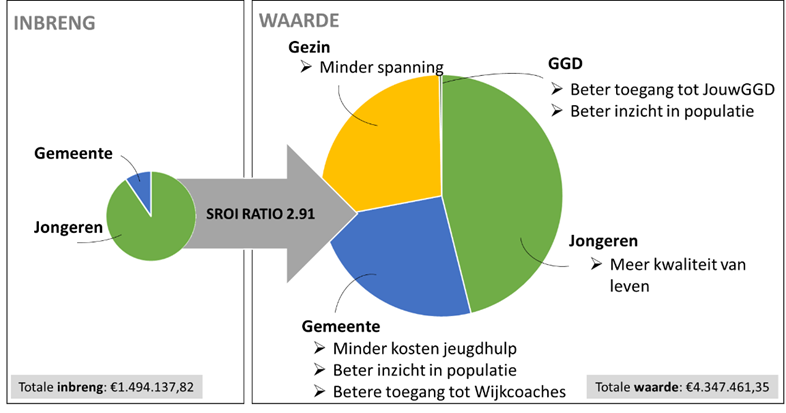Demonstrating the social added value of health technologies is becoming increasingly important. Healthcare is becoming more expensive, so in addition to financial returns, social impact is becoming more important. Do you wonder what added value implementing a health technology has on all stakeholders, or do you want to apply for a grant or funding for your health technology? Then demonstrating social impact according to the SROI method can help you do so.
The SROI method and what does it deliver?
We use the scientifically based Social Return on Investment (SROI) method to measure social impact. The SROI method differs from the well-known ROI method in that it not only measures what the financial investment of your health technology yields, but also what impact your health technology has on society. We do this by providing insight into the social return to all stakeholders. The result of the SROI Method is the SROI ratio, which shows the social return of your health technology in Euros compared to the investment.
The starting point of the SROI method is drawing up a clear health technology scenario together. Based on this scenario, we analyze what the stakeholders contribute (e.g. in terms of time or financial investment) and what value the health technology creates. By involving all stakeholders in the calculation of the SROI ratio, this method also leads to high involvement of all stakeholders.
When can you determine the social impact of your health technology?
The major advantage of the SROI method is that it can be applied at any point in health technology development. Roughly speaking, there are two types of SROIs. The prospective and retrospective. The prospective SROI, also called a quick scan, has a short lead time and can be used when applying for grants or (follow-up) funding for a health technology. The retrospective SROI can be used to evaluate a health technology and convince all stakeholders of its social value.
Case study
To gain insight into the social impact of a mobile application to increase young people's self-reliance, self-awareness and self-development, we conducted a SROI quick scan for SQUARE11. This quick scan, based on research and conversations with the client, revealed that the social impact of this mobile application lies primarily with young people, the family and the municipality. The SROI ratio of 2.91 indicates that after 3 years each invested euro grows to €2.91. This growth is mainly determined by more quality of life for the young people, less tension in the family and reduced costs of youth aid for the municipality.

Experience with the Quick Scan SROI prepared by RRD:
"For us, the SROI/ROI calculation is valuable to make it plausible to our clients (municipalities) that our intervention has social as well as financial impact. Costs precede benefits and this gives a nice (modest) picture of the potential of one and other. For policy advisors of municipalities it is easier for them to justify internally what they are using certain budgets for. So it has given us tools to substantiate and strengthen our business case." Danny Hoendervangers (Square 11)
Measure the social impact of your healthcare innovation yourself?
In addition to working with you to determine the social impact for your healthcare innovation, RRD also offers the SROI master class in collaboration with Vita Valley. During this multi-day master class, you will receive an explanation of the SROI method and learn how to apply it yourself. The end result of this master class is an SROI quick scan for your own healthcare innovation.